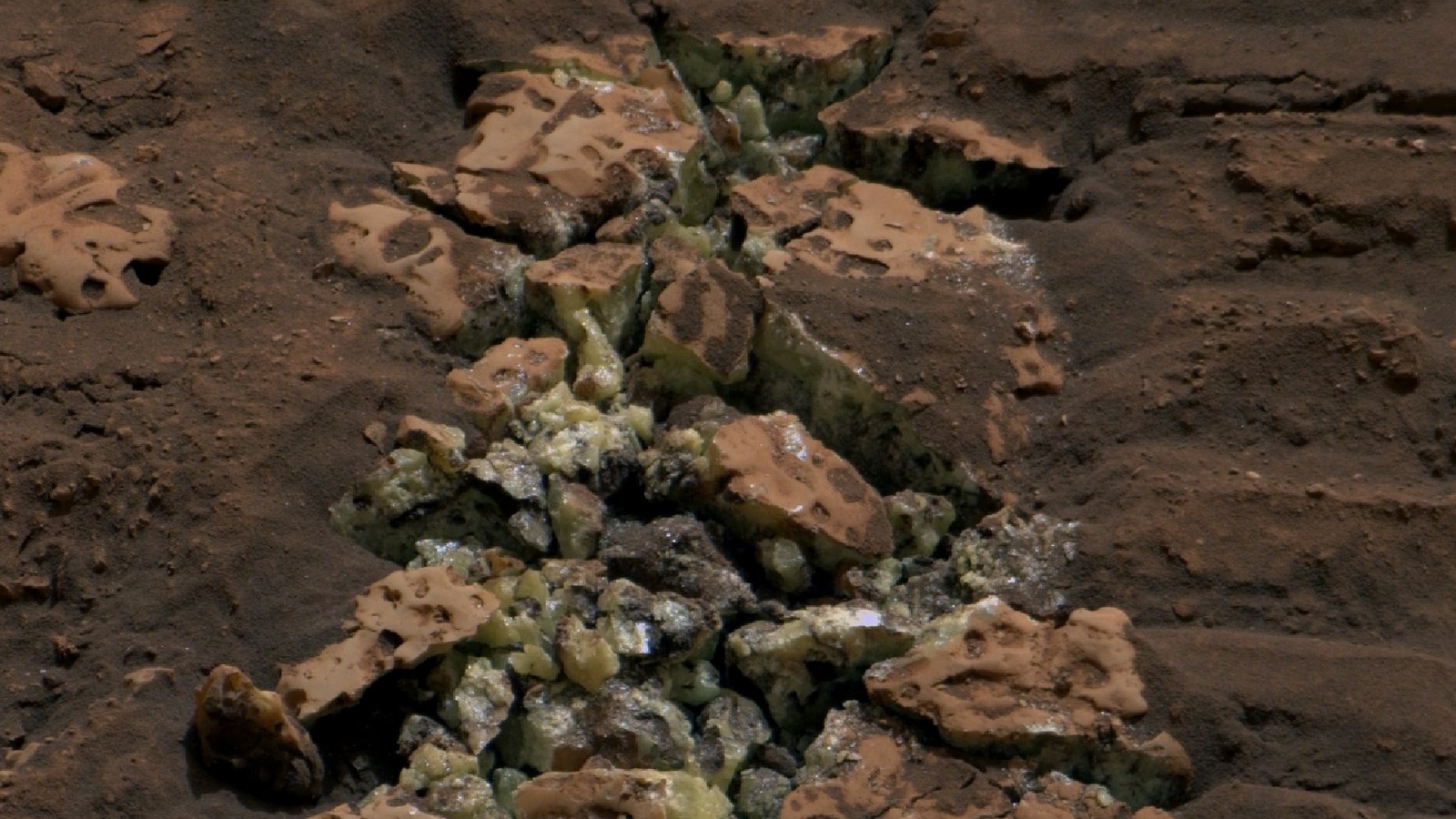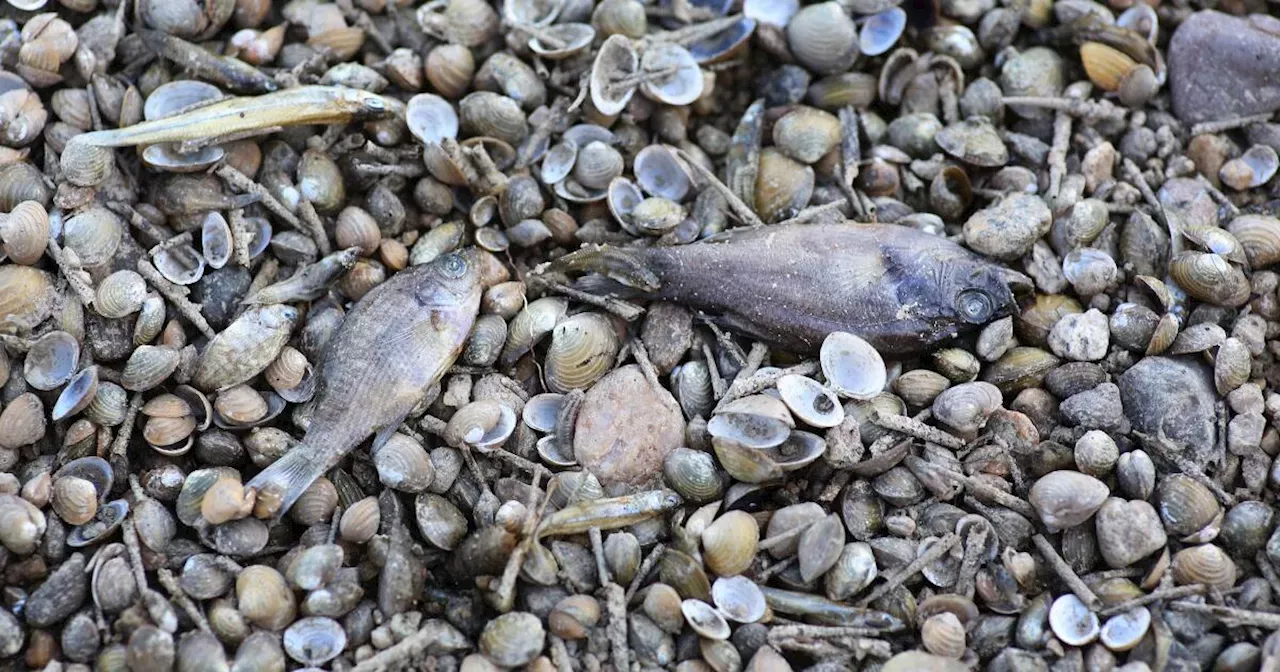NASA ’s Curiosity rover’s newest “mind-blowing” discovery on Mars has found yellowish-green crystals of pure sulfur, which have never been seen on the Red Planet. Scientists say the rover made the unprecedented discovery after driving over a pile of rocks and cracking one open during its probe of the Gediz Vallis channel. The unexpected unearthing has revealed a new existence that “shouldn’t be there,” making for the first of its kind finding in the past 30 years of the planet’s exploration.
Evidently, the discovery made by accident was like “finding an oasis in the desert,” Ashwin Vasavada, Curiosity ’s project scientist at NASA’s Jet Propulsion Laboratory in Pasadena, California . Moreover, it’s not like the rover only chanced upon a handful of these rocks made of pure sulfur; instead, an entire field has exposed the scientists to tons of them. “Discovering strange and unexpected things is what makes planetary exploration so exciting,” Vasavada added.

Also read | Did The Simpsons predict Kamala Harris would be US president? Stunning theories float @MarsCuriosity added the exciting happening to its online journal and posted online: "*Cronch* I ran over a rock and found crystals inside! It's pure sulfur. (And no, it doesn’t smell.) Elemental sulfur is something we’ve never seen before on Mars.
We don't know much about these yellow crystals yet, but my team is excited to investigate." Curiosity's official X/Twitter update left many wondering how the sulfur discovery didn't smell. “Helloo, people associate sulfur with the odour from rotten eggs, and that's the result of hydrogen sulfide gas, but elemental sulfur is odourless.
It forms in only a narrow range of conditions that scientists haven’t associated with the history of this location,” the Mars rover 's page shortly clarified. Why this discovery is groundbreaking? As already established, sulfur is a key ingredient for life, one of the six building blocks, along with carbon, hydrogen, nitrogen, oxygen, and phosphorus. What makes this discovery even more groundbreaking is that these elements together constitute 98% of living matter on Earth.
This consideration has once again led the scientists down to the proverbial black hole of possibilities and questions surrounding the Red Planet’s potential life-bearing conditions and history. Check out Curiosity's discovery: Also read | ‘I got fired from CrowdStrike,' Indian-origin man ‘not really sure’ why he was sacked: Another employee meme? The Mars rover had previously found sulfates or salts containing sulfur on the planet, which formed upon water evaporation. The team of scientists tied to the project had even located white calcium sulfate (gypsum) on the ample number of cracks in the Martian surface, signalling the presence of hard-water deposits caused by ancient groundwater flows.
However, finding “pure sulfur” was not even on “their bingo card,” Vasavada exclaimed. Vasavada also pointed out that while such rocks have a “beautiful, translucent and crystalline texture,” their discovery’s presence on the Martian surface and further exposure to weathering resulted in a camouflage effect as the rocks blended in with the planet’s, largely defined by shades of orange. They ultimately fathomed the “gorgeous texture and colour inside” of the rock and used the rover’s resources to analyse it; consequently, the data proved it was pure sulfur.
Similar to this accidental discovery, NASA’s Spirit rover also fortuitously discovered nearly pure silica, again suggesting that hot springs or steam vents may have once existed on the planet. This finding, too, insinuates that such presences could make room for favourable conditions for microbial life, at least if it ever existed. Also read | National Ice Cream Day deals: Wendy's, Dairy Queen and more offering freebies Curiosity did not, in fact, kill the cat but again found a friend in a lucky accident The Curiosity rover chanced upon its “strangest” and “most unexpected” find while investigating the Gediz Vallis channel, which seems to have been created 3 billion years ago by flowing water and debris.
CNN reported Vasavada’s revelations through the Curiosity project, claiming that the channel is dug out on the side of the 5-kilometre-tall Mount Sharp, which the rover has been mounting since 2014. The project scientist and his team reviewed the rover's images, which showed a crushed rock lying in its wheel tracks. “I have to say, there’s a lot of luck involved here.
Not every rock has something interesting inside,” Vasavada told CNN, claiming that luck played a significant role in their newest discovery, which has only expanded their questionnaire to the Red Planet's intriguing mysteries..



















